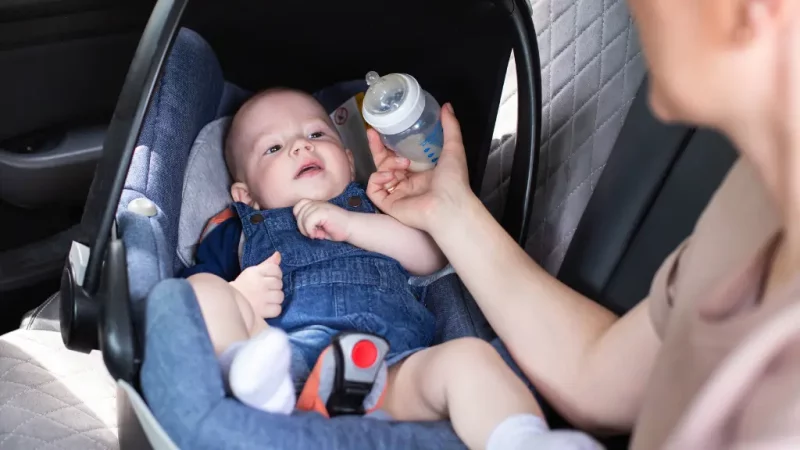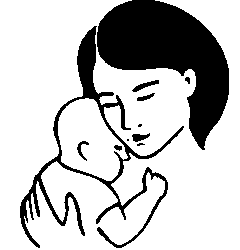As a busy parent, you’ve likely wondered if it’s okay to quickly feed your fussy newborn a bottle while they’re buckled into their car seat.
Despite the temptation for convenience, the clear answer pediatricians give is no – you should not feed an infant in their car seat whether stopped or moving.
Newborns have a sensitive choking reflex and poor head/neck control, making a car seat one of the most dangerous places you could feed them. Strapped in and unable to move away, choking hazards and aspiration risks abound.
In this post, we’ll cover why it’s so strongly warned against and the best practices for feeding babies safely on the go.

The Risks of Feeding a Baby in a Car Seat
Putting anything in a newborn baby’s mouth while they are strapped into a car seat carries some risks. Here are the main concerns with feeding a newborn in their car seat:
Choking Hazard
Baby car seats are designed to transport babies safely, not feed them. When a baby is drinking from a bottle, milk can pool in their mouth and throat.
If they choke or start coughing and are unable to push the milk out of their airway, this can lead to a dangerous situation since they can’t quickly move their head or reposition their body when strapped into a car seat.
Risk of Aspiration
Similar to the choking hazard, a newborn can aspirate (inhale fluid into their lungs) when drinking a bottle while strapped into their car seat. This could lead to breathing issues, aspiration pneumonia, or even SIDS.
Difficulty Breastfeeding Afterwards
Lying flat in a car seat can interfere with a baby’s ability to properly latch when you go to breastfeed them afterward. The different positioning makes it harder for them to take the breast properly.
Decreased Leg Circulation
Having a baby’s legs bent for a prolonged time while in their car seat can restrict blood circulation to their lower limbs and feet. This could cause issues over time.
Overheating
Car seats trap heat, so drinking a warm bottle while strapped in could cause the baby to become uncomfortably hot very quickly. Dehydration and heat stroke are serious risks.
Distracted Driving
If you are bottle feeding your baby in their rear-facing car seat while driving, this can dangerously divide your attention and take your eyes off the road. Just like texting while driving, this impairs your ability to react in an emergency and puts other drivers at risk.
So, while it may be tempting to quickly feed your hungry newborn their bottle on the go, there are definite safety hazards with allowing baby to eat in their car seat. Continue reading to learn the best practices for feeding a newborn while out and about.
When Can You Feed a Baby in Their Car Seat?
The American Academy of Pediatrics officially recommends you do not feed a baby (whether breastfed or bottle-fed) while they are sitting in a car seat.
This applies to moving vehicles and when the baby is strapped into their car seat outside the car. So, no bottle propping or letting baby breastfeed in their car seat on the go.
However, for very brief soothing feeds, stopping to feed the baby while they are still locked into their car seat isn’t necessarily dangerous. Just exercise extreme caution. Pull over safely, never leave the baby unattended, and pay close attention to the entire feed to avoid any choking or aspiration risks.
Best Practices for Feeding Baby on the Go
When you’re out running errands, and your baby gets fussy from hunger, find a safe place to pull over and feed them properly. Here are some best practices:
Stop Somewhere Safe
If driving, safely pull over and put your hazard lights on if needed. Never feed the baby while actively driving.
If on foot, find a bench or grassy area to sit and feed the baby.
Take Baby Out of Car Seat
Unbuckle the baby from the restraints and lift them out of the seat to feed them. Hold the baby upright on your lap, or let them recline in the crook of your arm.
Stay Close By
If bottle feeding, always hold the bottle yourself – no propping bottles. If breastfeeding, bring a cover for privacy if needed. Never leave the baby alone.
Keep It Brief
Limit feedings to 10 minutes max. Watch baby closely the entire time and stop immediately if they choke, cough, or have trouble breathing.
Burp Afterwards
Properly burp the baby by gently patting or rubbing their back before strapping them back into their car seat restraints.
What About Infant Car Seat Carriers?
Infant car seat carriers that click onto a base or stroller are designed for convenience but still pose a risk for feeding an infant. Even if they are detached from the base and in a more reclined, stroller-like position, it’s best to take the baby out of the seat entirely whenever possible during feeding time.
If you need to briefly feed the baby in a pinch while they’re in the detachable infant seat, pull over someplace safe, never leave them unattended, keep the feed under 10 minutes, sit baby primarily upright, and burp them well afterward.
Signs Baby Shouldn’t Be Fed in Their Car Seat
While it’s not recommended in general, most babies can tolerate a very brief feed in their car seat if needed – but some babies are at higher risk. Avoid feeding the following newborns in their car seat:
- Preemies
- Babies with reflux
- Babies who get severe choking or gagging episodes
- Babies with special needs or disabilities that impair their ability to swallow safely
If your baby falls into any of these categories or you have concerns about their ability to feed safely, take extra precautions and permanently remove them from the car seat to feed. Don’t take any chances with higher-risk infants when it comes to car seat feeding safety.
Other Car Seat Safety Tips for Newborns
Besides no eating in the car seat, here are some other top car seat safety tips from pediatricians to keep in mind:
Properly Recline the Seat
Newborns have poor head and neck control, so they need to ride with their car seat reclined at an appropriate angle. Generally, a 45-degree incline is best to keep their airway open.
No Loose Objects
Don’t let the baby hold toys or anything else during drives that could injure them in a crash or interfere with the straps.
Dress Appropriately
Never overdress or cover baby with blankers in their car seat, which can lead to dangerous overheating.
Regular Breaks
Plan to stop every 2 hours or so on road trips to take the baby out of their seat for feeds, diaper changes, and to stretch. Avoid extended periods of immobility.
The Takeaway on Feeding Newborns in Car Seats
It’s generally not recommended or safe for most newborn babies to be fed – whether breast or bottle – while strapped into their car seat. Choking hazards, aspiration risks, and overheating are some of the dangers pediatricians warn to avoid by constantly removing babies from the car seat to feed them properly.
However, for very short feeds under 10 minutes on occasion, if you’re in a pinch, it’s possible to feed a newborn safely in their car seat as long as you take extreme care and precaution.
Just know the risks, limit how often you do this, stop somewhere safe, keep them sitting upright, stay present the whole time, and watch them like a hawk for signs of trouble.
As babies get older and have better strength and mobility, car seat feeding becomes less risky. But when it comes to delicate newborns, don’t take any chances – take them out of that car seat before feeding them whenever you can. Their safety is priority number one!
conclusion
Feeding newborns is an around-the-clock job. When you’re out running errands with a fussy, hungry baby, it can be tempting to prop up a bottle in their car seat to help tide them over.
However, both the American Academy of Pediatrics and pediatricians strongly advise against letting babies eat strapped into their car seats. At best, it’s inconvenient; at worst, it poses severe choking, aspiration, and overheating dangers.
While the convenience factor is understandable for busy, multi-tasking parents, the baby’s safety has to come first. Always take the time to stop somewhere safe, unbuckle the baby, and hold them in your arms for proper supervised feeding time.
Limit any in-seat feeds to emergencies only, watch them like a hawk the entire time, and avoid car seat feeds altogether for preemies or babies with medical conditions.
It only takes a split second for a newborn feeding to go wrong and end in tragedy. When considering feeding a baby in their car seat, weigh the risks and follow best practices to keep this defenseless little bundle safe. Their life truly depends on it.

1 thought on “Can You Feed a Newborn Baby in Their Car Seat?”